‘I took someone’s life — now I am giving back’: In California’s prisons, inmates teach each other how to start over

As California prison officials shift toward inmate programs centered on rehabilitation and education, they are evaluating new regulations for awarding time credits for good behavior and reaching milestones.
The men Daniel Hopper teaches about drug and alcohol abuse are serving sentences of 10 years to life at a state prison tucked away in the Vaca Mountains of Northern California. They grew up in different places, most of them under difficult circumstances: dangerous schools and neighborhoods, fathers behind bars, brothers in gangs.
Hopper, a tall 35-year-old with cropped black hair, rectangular glasses and piercing wit, can relate to them on a level few others can. He is doing time for killing another teenager when he was 17 and a San Diego gang leader.
“Going to prison was one of the best things that ever happened to me,” Hopper said. It forced him to face what he did — and live differently, he said.
A largely self-educated inmate who had resigned himself to dying within prison walls, Hopper became a substance abuse counselor through the Offender Mentor Certification Program. Now, with Proposition 57 ushering in a massive overhaul of the state’s prison parole system, the program could bring him and his students closer to an early release that some of them thought they would never see.
California corrections officials unveiled new regulations last month that will expand the credits some inmates earn for demonstrating good behavior and completing educational programs like Hopper’s. The highly anticipated — and fiercely debated — guidelines could help trim the sentences of nearly 2,000 inmates over the next fiscal year.
Corrections officials said the growing emphasis on rehabilitation and helping offenders re-enter society has led to a prison culture shift. Inmates at facilities with the most opportunities seem less inclined to break the rules, officials said, showing a greater interest in group sessions, completing college applications and learning work skills.
There is a lot of talk of hope, and Hopper and other prisoners said it doesn’t feel empty.

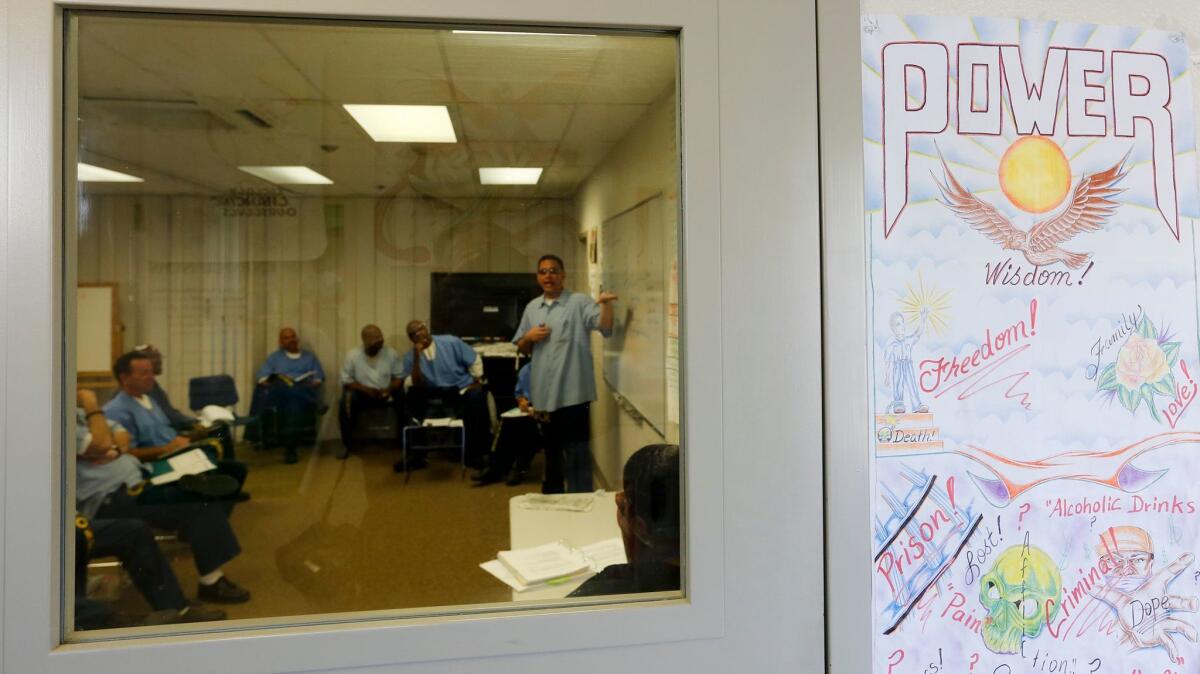
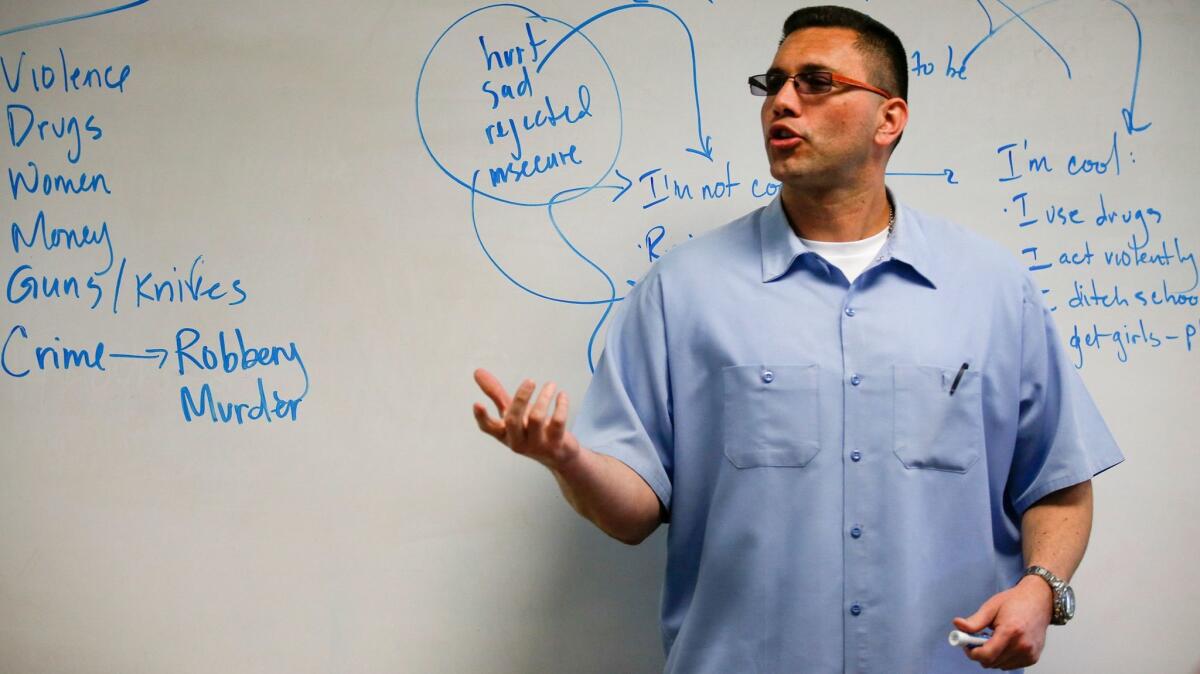
At the state prison in Solano County, Hopper’s substance abuse class meets twice a week in a partitioned room whose gray walls are plastered with ethics rules. Dressed in pale blue prison scrubs, Hopper scribbled on a whiteboard with a dry-erase marker.
He asked about a dozen men slouched in plastic chairs to give him an example of a high-risk situation — the type of scenario, he said, where their past and “faulty core beliefs” could trigger a relapse into harmful or criminal behavior.
“Coming around negative peers,” called out Julio Santos, a 36-year-old from South Los Angeles who at 26 was convicted of murder and two counts of attempted murder, with enhancements for gun possession and gang affiliations.
“So this is a person? People? What kind of people?” Hopper questioned as he pressed for details.
“Gang members,” Santos responded.
“Why are gang members a high-risk situation for you?” Hopper asked.
Pacing back and forth, Hopper invited the inmates to provide examples of gang culture and what they represent to them. Women, drugs and money, they responded. Respect, acceptance and being cool.
“So, what assumptions am I making when I see a gang member?” he asked. “What beliefs do they trigger in me? Because I like it. I like the image, the respect, the acceptance, the meaning, the coolness. I like all that. But that tells me something: I believe something about them that creates a temptation for me.”
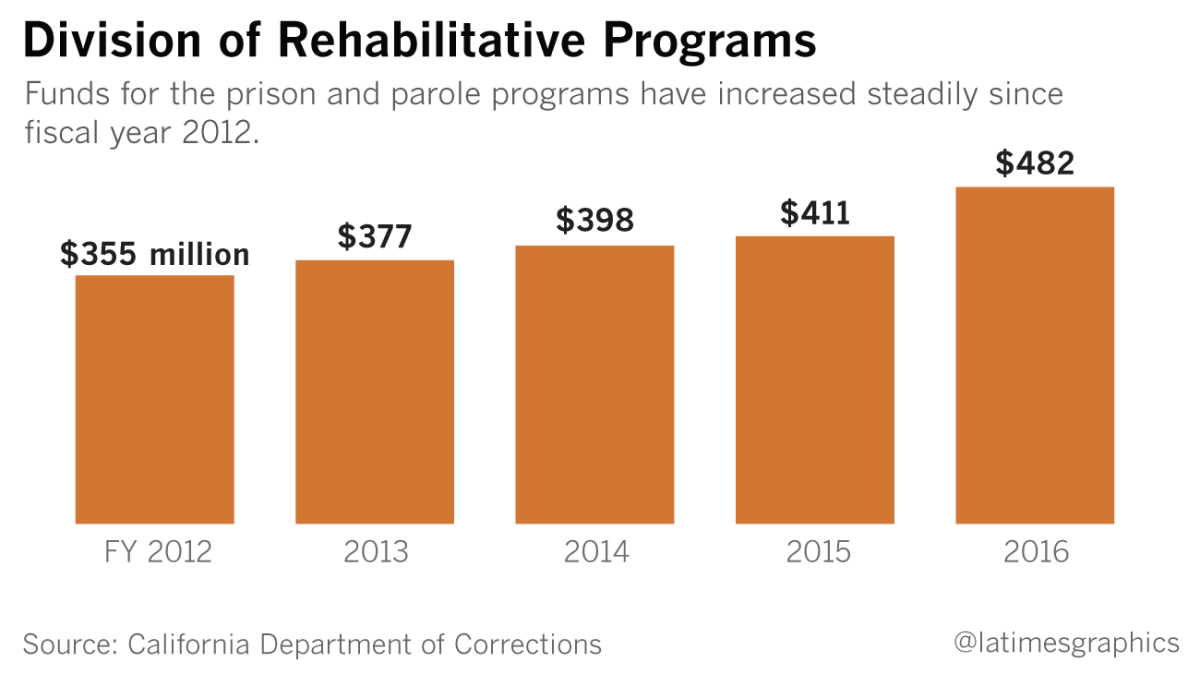
California plans to release 9,500 offenders over the next four years under Proposition 57, part of the state’s strategy to comply with a federal court-ordered cap on the state inmate population. Gov. Jerry Brown has billed it as a thoughtful response to prison overcrowding. But to keep people from cycling in and out of the system, state officials say, prisons must prepare inmates for life on the outside.
“This is one of the things no one wants to talk about,” Brown said at an annual crime victims’ rally earlier this month. “That you lock somebody up doesn't mean the end of the story.”
State spending on prison rehabilitation programs — part of the California Department of Corrections and Rehabilitation budget, which is mostly supported by the state's general fund — has steadily grown over the last five fiscal years, from roughly $355 million in 2012 to nearly $482 million in 2016. Corrections officials say it’s producing positive outcomes. A 2016 state report found that the total three-year recidivism rate for all California felons — percentage of those who reoffend three years after their release — dropped to 44.6% from a peak of 67.5% in fiscal year 2010.
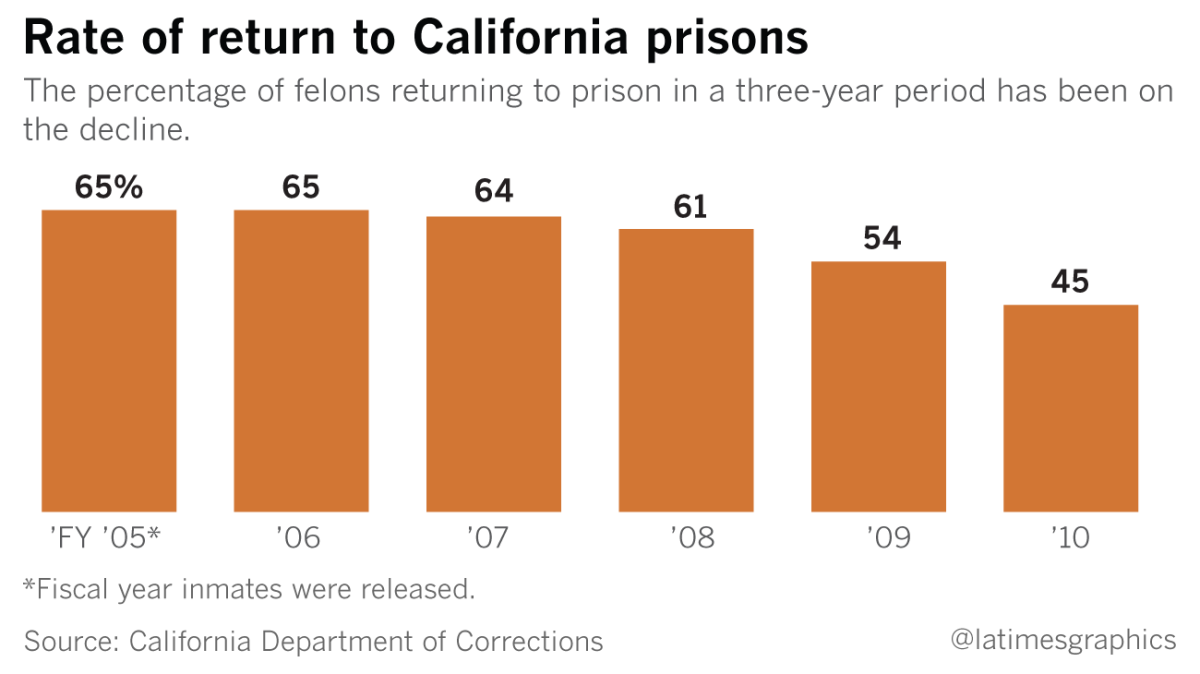
Through Proposition 57, state officials want to increase prisoner enrollment in work, education and rehabilitation initiatives by expanding the amount and types of credits inmates can earn for time served toward their sentences.
Incremental changes to the credit system are to begin as early as May, depending on public input, after the guidelines released last month won temporary approval. Inmates could soon cut up to six months off their sentences for earning a high school diploma or college degree, and up to a month each year for successfully completing self-help programs — such as substance abuse support groups, counseling, and parenting or anger management classes.
They also will have the chance to earn greater “milestone” credits, awarded for achieving goals within some programs. Those could allow a sentence reduction of up to 12 weeks in a 12-month period.
Educational and milestone merit programs for inmates vary from one prison to another, and wardens at each institution are evaluating hundreds of other initiatives and activities that could fall under the new “rehabilitative achievement” category.
The ideas for programs can spring from community organizations, prison officials, legislation — even inmates themselves. All adult institutions, for example, offer associate of arts degrees in partnership with community colleges. Within some prisons, offenders can work on dairy farms, gardens or clothing factories. At the state prison in Chino, they learn the physics, medicine and mechanics behind deep sea diving, training with the aim of someday becoming commercial divers, underwater welders or heavy construction riggers.
“We have a lot of people who come to prison who have never had a job,” said Charles Pattillo, general manager of the California Prison Industry Authority, a state-run agency that manages more than 100 work programs at 34 state prisons. “So, we have to have the real basic programs to build up the work ethic and move up from there.”

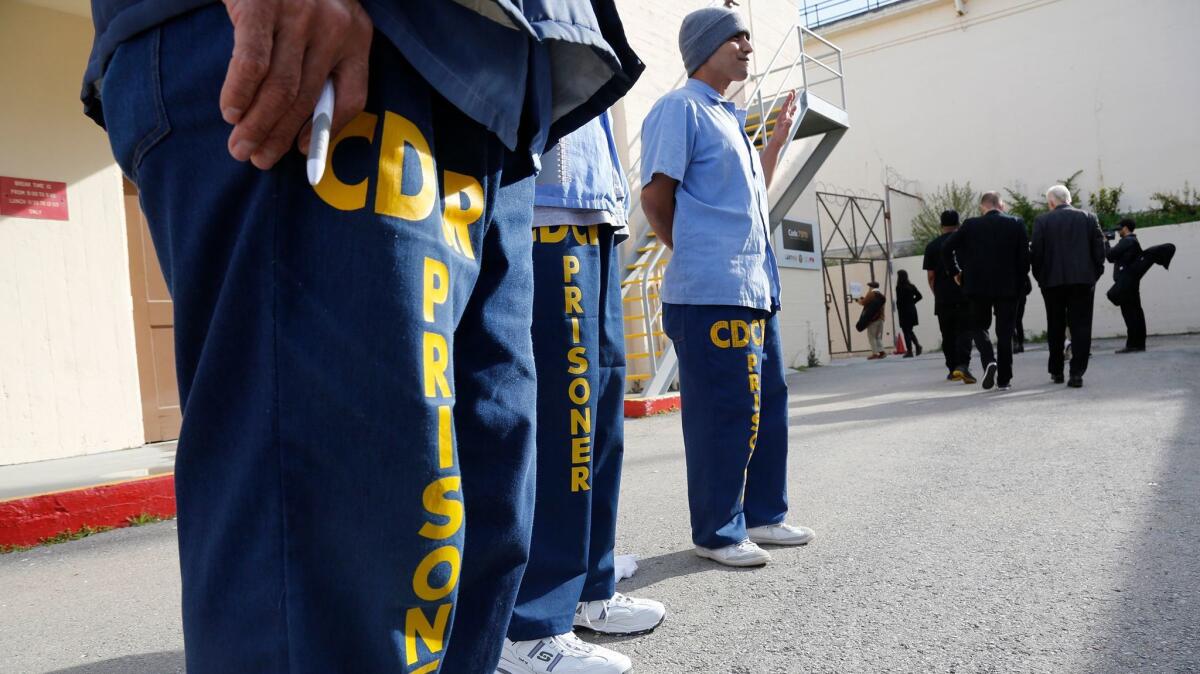

One of the most innovative milestone credit programs is at San Quentin, the oldest prison in the state. On a closed network — they are not allowed to use the Internet — inmates learn how to write computer code in hopes of landing a high-paying job after doing time.
The Last Mile, founded by venture capitalist Chris Redlitz and his wife, Beverly Parenti, teaches offenders logo design, data visualization and web development skills, including programming languages such as HTML and Python. Inmates help build apps, websites and other software for small start-ups and even larger companies such as Airbnb.
At a March graduation ceremony for a Last Mile class called Code.7370, representatives from Google, Facebook and other Silicon Valley companies, clad in all black, mingled with inmates in blue prison uniforms, some of whom had been locked up long before the release of the first iPhone.
Cordiare McDonald, who has been serving a 13-year sentence for armed robbery since January 2007, was one of the graduates. McDonald, 30, grew up in Pomona with a father in and out of prison. The new voter-approved parole rules could help him go home sooner, and he said he doesn’t want to come back.
He aspires to work in web development and said solving coding problems has taught him patience.
“In the past, my solution to a problem was finding a cheap trick to get what I wanted fast, no matter who I hurt in the process,” McDonald told the audience of about 200 people.
At California State Prison-Solano, which Gov. Jerry Brown recently visited, inmates could potentially earn Proposition 57 credits from nearly 200 programs, including classes for youth offenders and jobs making eyeglasses for Medicare and Medicaid patients. Inmates said the passage of the ballot measure has given them motivation to set goals and strive harder.
They said they also felt more prepared to leave. Hopper’s mentee Santos said he was learning to align his actions with his values. He was 3 when his father died, and like Hopper, he became involved with gangs in his teens after enduring bullying at school.
These days, he wants to prevent others from making similar mistakes.
“I took someone’s life — now I am giving back,” he said.
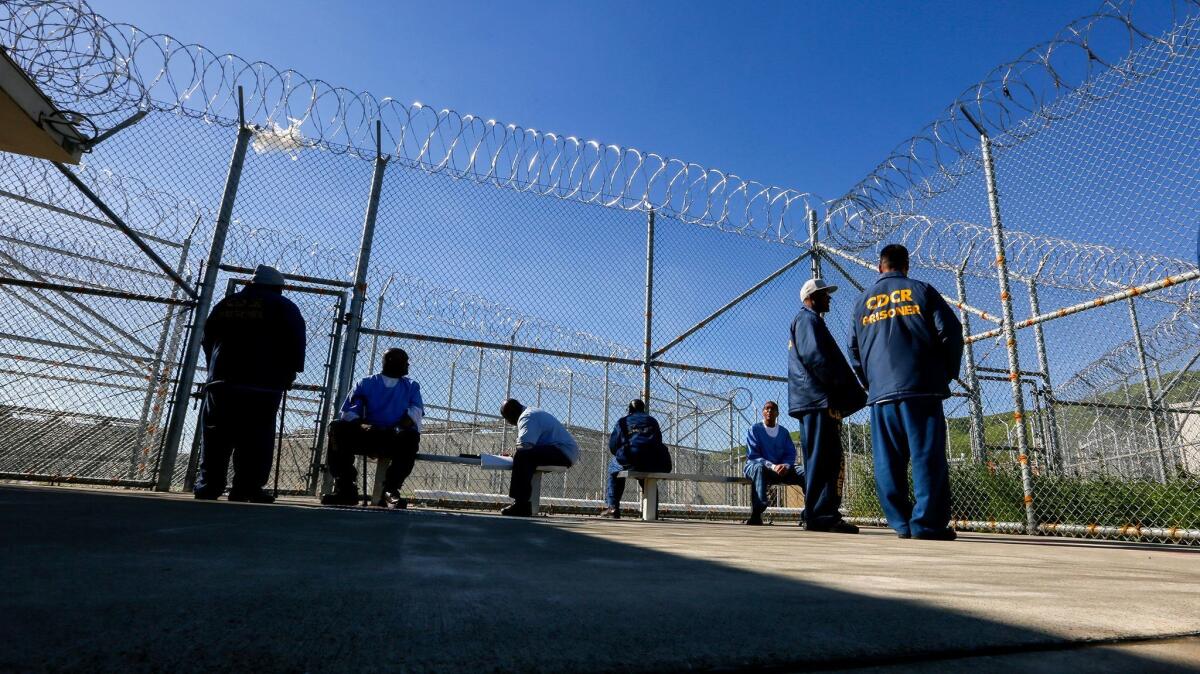
But Proposition 57 has its critics, too, in a larger battle over California’s direction on crime and punishment. As Brown has sought to move the state away from a focus on mandatory sentences, some district attorneys and law enforcement officials argue he has gone too far.
Debate has centered on which offenders are redeemable. Under the new regulations, all sex offenders, death row inmates and prisoners serving life without the possibility of parole are excluded from eligibility for early parole consideration. But sex offenders are not exempt from earning credits that could potentially cut their sentences.
Violent offenders could receive up to 20% of time served for good behavior, up from 15% in previous guidelines.
Hopper said what starts off for many prisoners simply as a way to go home soon results in something more meaningful.
“You are constantly in an environment that has its own culture, a culture of rehabilitation, a culture where guys are constantly asking you to reexamine your thinking,” he said. “As a result, little by little, you start to crack at the heart.”
Hopper’s own change has been hard and slow. Twenty-five years ago, he taught younger members of his gang how to retaliate against rivals who ran them out of their territory in San Diego. He shot and killed a 16-year-old in an ambush, thinking it would “mean permanent status [in the gang] — people will respect me, fear me and not mess with me.”
Instead, it led to a sentence of 50 years to life in prison for first-degree murder, with his first chance at parole in 2048. A few years in, he resigned himself to the punishment, stopped appealing his case and started searching for purpose in philosophy books he ordered from college pamphlets his sister mailed him.
In recent years, as California began grappling with a ballooning prison population, Hopper has seen his chances increase for getting out earlier. Proposition 57 could send him before the parole board as early as next year.
He hopes to become a college professor.
“I struggled to educate myself; that’s why I understand how others learn best,” he said.
But for offenders who have faced the parole board in the past, new credits under the measure might not make a difference even if they receive them. The achievements will not advance their next parole hearing, and for some of those inmates, like John Badgett, 48, society might not care how much they have changed.
Now a substance abuse counselor in the mentor program, Badgett and his brother killed and dismembered a friend they believed would snitch about a robbery.
Rehabilitation classes have helped him understand the childhood abuse, poverty and addiction that drove him to believe “violence was a solution to anger,” Badgett said. He was found suitable for parole in 2016, but denied by the governor.
Before she died, his victim’s mother wrote him to say that she wished he would stay in prison for the rest of his life. He thinks about that letter every day and accepts why some believe he should not be let out.
“She described the monster that I had become, the callousness, the person who had done this to her baby boy,” he said between long pauses. “She lost everything.”
ALSO:
Governor's budget gives a glimpse into challenges ahead for prison parole overhaul in California
What is a 'violent crime'? For California's new parole law, the definition is murky— and it matters
Proposition 57, Gov. Jerry Brown's push to loosen prison parole rules, is approved by voters
Why Gov. Jerry Brown is staking so much on overhauling prison parole
Get the L.A. Times Politics newsletter
Deeply reported insights into legislation, politics and policy from Sacramento, Washington and beyond. In your inbox three times per week.
You may occasionally receive promotional content from the Los Angeles Times.








